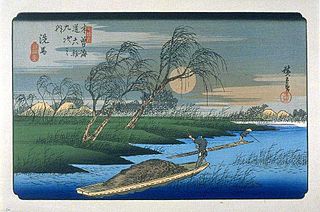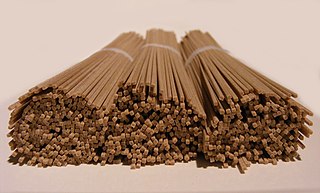
Kiso District is a district located in Nagano Prefecture, Japan.

Kanō-juku was the fifty-third of the sixty-nine stations of the Nakasendō. It is located just south of JR Gifu Station in Gifu, Gifu Prefecture, Japan. During the Edo period, it was an independent post town that was approximately 2.3 km (1.4 mi) wide, making it the largest post towns in Mino Province.

Gōdo-juku was the fifty-fourth of the sixty-nine stations (shukuba) of the Nakasendō. It is located in the present-day city of Gifu, Gifu Prefecture, Japan. Gōdo-juku flourished as a post town because it was located next to the Nagara River and there was a ferry service to the other side.

Hosokute-juku was the forty-eighth of the sixty-nine stations of the Nakasendō during the Edo period and it is located in the present-day city of Mizunami, Gifu Prefecture, Japan.

Akasaka-juku was the fifty-sixth of the sixty-nine stations of the Nakasendō. It is located in the present-day city of Ōgaki, Gifu Prefecture, Japan. It flourished during the Edo Period, as it was located in a fertile valley, next to a river.

Mitake-juku was the forty-ninth of the sixty-nine stations of the Nakasendō. It is located in the present-day town of Mitake, Kani District, Gifu Prefecture, Japan.

Shiojiri-shuku was the thirtieth of the sixty-nine stations of the Nakasendō. It is located in the central part of the present-day city of Shiojiri, Nagano Prefecture, Japan.

Shimosuwa-shuku was the twenty-ninth of the sixty-nine stations of the Nakasendō, as well as being the ending location of the Kōshū Kaidō. It is located in the present-day town of Shimosuwa, Suwa District, Nagano Prefecture, Japan.

Banba-juku was the sixty-second of the sixty-nine stations of the Nakasendō. It is located in the present-day city of Maibara, Shiga Prefecture, Japan.
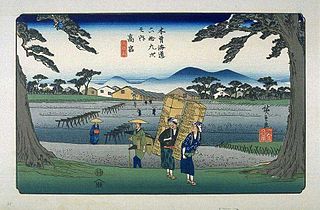
Takamiya-juku was the sixty-fourth of the sixty-nine stations of the Nakasendō. It is located in the present-day city of Hikone, Shiga Prefecture, Japan on the right bank of the Inukami River. It stretches from the center of the city out towards the east. It became a post town shortly after its original founding during the Warring States period. Takamiya was the entrance station of Taga-taisha shrine and a big torii exists at the center of Takamiya. Today, Ohmi Railway Taga Line connects Takamiya Station and Taga Taisha-mae Station.

Niekawa-juku was the thirty-third of the sixty-nine stations of the Nakasendō. It is located in the present-day city of Shiojiri, Nagano Prefecture, Japan.
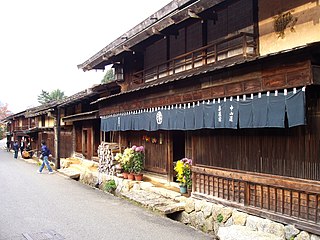
The Kisoji was an old trade route in the Kiso Valley that stretched from Niekawa-juku in Nagano Prefecture to Magome-juku in Gifu Prefecture. There were eleven resting spots along the route, all of which became part of the Nakasendō when it was established. There is an article dating from 713 in the Shoku Nihongi that records the routes characters as 吉蘇路.

Narai-juku was the thirty-fourth of the sixty-nine stations of the Nakasendō, as well as the second of eleven stations along the Kisoji. It is located in the present-day city of Shiojiri, Nagano Prefecture, Japan.
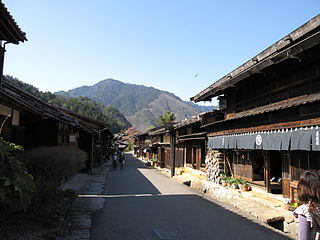
Shukuba (宿場) were post stations during the Edo period in Japan, generally located on one of the Edo Five Routes or one of its sub-routes. They were also called shuku-eki (宿駅). These post stations were places where travelers could rest on their journey around the nation. They were created based on policies for the transportation of goods by horseback that were developed during the Nara and Heian periods.

The Sixty-nine Stations of the Kiso Kaidō or Sixty-nine Stations of the Kiso Road, is a series of ukiyo-e works created by Utagawa Hiroshige and Keisai Eisen. There are 71 total prints in the series. The common name for the Kiso Kaidō is "Nakasendō," so this series is sometimes referred to as the Sixty-nine Stations of the Nakasendō. It is a follow up to Hiroshige's The Fifty-three Stations of the Tōkaidō and he produced 47 of the prints, with Eisen being responsible for the rest.

Shio no Michi was an old kaidō, or road, in ancient Japan and was used to transport salt from the ocean to the inland central Honshū. In the Middle Ages, salt was brought both from the Sea of Japan and the Pacific Ocean to Shinano Province for processing. The road leading from the Sea of Japan to Shinano Province was called the Chikuni Kaidō (千国街道), whereas the road leading from the Pacific Ocean was called the Sanshū Kaidō (三州街道).




